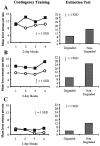The role of the nucleus accumbens in instrumental conditioning: Evidence of a functional dissociation between accumbens core and shell
- PMID: 11312310
- PMCID: PMC6762583
- DOI: 10.1523/JNEUROSCI.21-09-03251.2001
The role of the nucleus accumbens in instrumental conditioning: Evidence of a functional dissociation between accumbens core and shell
Abstract
In three experiments we examined the effect of bilateral excitotoxic lesions of the nucleus accumbens core or shell subregions on instrumental performance, outcome devaluation, degradation of the instrumental contingency, Pavlovian conditioning, and Pavlovian-instrumental transfer. Rats were food deprived and trained to press two levers, one delivering food pellets and the other a sucrose solution. All animals acquired the lever-press response although the rate of acquisition and overall response rates in core-lesioned animals were depressed relative to that in the shell- or sham-lesioned animals. Furthermore, in shell- and sham-lesioned rats, post-training devaluation of one of the two outcomes using a specific satiety procedure produced a selective reduction in performance on the lever that, in training, delivered the prefed outcome. In contrast, the core-lesioned rats failed to show a selective devaluation effect and reduced responding on both levers. Subsequent tests revealed that these effects of core lesions were not caused by an impairment in their ability to recall the devalued outcome, to discriminate the two outcomes, or to encode the instrumental action-outcome contingencies to which they were exposed. Additionally, the core lesions did not have any marked effect on Pavlovian conditioning or on Pavlovian-instrumental transfer. Importantly, although shell-lesioned rats showed no deficit in any test of instrumental conditioning or in Pavlovian conditioning, they failed to show any positive transfer in the Pavlovian-instrumental transfer test. This double dissociation suggests that nucleus accumbens core and shell differentially mediate the impact of instrumental and Pavlovian incentive processes, respectively, on instrumental performance.
Figures







References
-
- Adams CD, Dickinson A. Instrumental responding following reinforcer devaluation. Q J Exp Psychol. 1981;33B:109–122.
-
- Alheid GF, Heimer L. New perspectives in basal forebrain organization of special relevance for neuropsychiatric disorders: the striatopallidal, amygdaloid, and corticopetal components of substantia innominata. Neuroscience. 1988;27:1–39. - PubMed
-
- Balleine BW. Asymmetrical interactions between thirst and hunger in Pavlovian-instrumental transfer. Q J Exp Psychol B. 1994;47:211–231. - PubMed
-
- Balleine BW. Incentive processes in instrumental conditioning. In: Mowrer R, Klein S, editors. Handbook of contemporary learning theories. LEA; Hillsdale, NJ: 2000. pp. 307–365.
-
- Balleine BW, Dickinson A. Goal-directed instrumental action: contingency and incentive learning and their cortical substrates. Neuropharmacology. 1998a;37:407–419. - PubMed
Publication types
MeSH terms
Substances
Grants and funding
LinkOut - more resources
Full Text Sources
